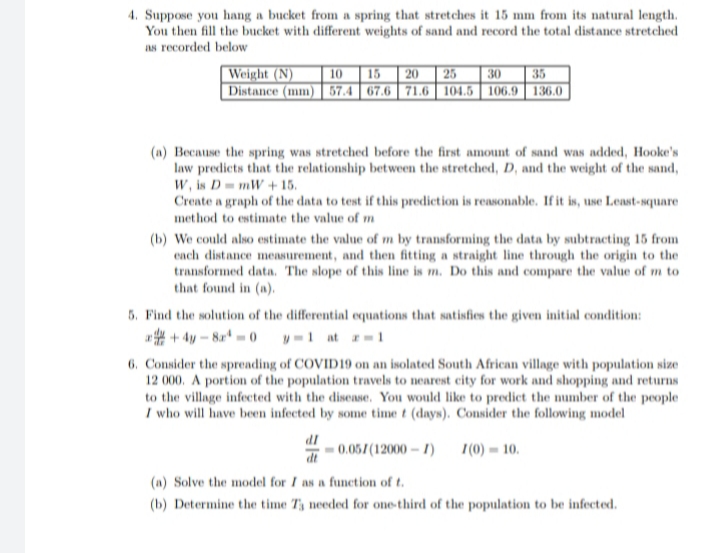4. Suppose you hang a bucket from a spring that stretches it 15 mm from its natural length. You then fill the bucket with different weights of sand and record the total distance stretched as recorded below Weight (N) 10 15 20 25 30 35 Distance (mm) 57.4 67.6 71.6 104.5 106.9 136.0 (a) Because the spring was stretched before the first amount of sand was added, Hooke's law predicts that the relationship between the stretched, D, and the weight of the sand, W, is DmW + 15. Create a graph of the data to test if this prediction is reasonable. If it is, use Least-square. method to estimate the value of m (b) We could also estimate the value of m by transforming the data by subtracting 15 from each distance measurement, and then fitting a straight line through the origin to the transformed data. The slope of this line is m. Do this and compare the value of m to that found in (a).
4. Suppose you hang a bucket from a spring that stretches it 15 mm from its natural length. You then fill the bucket with different weights of sand and record the total distance stretched as recorded below Weight (N) 10 15 20 25 30 35 Distance (mm) 57.4 67.6 71.6 104.5 106.9 136.0 (a) Because the spring was stretched before the first amount of sand was added, Hooke's law predicts that the relationship between the stretched, D, and the weight of the sand, W, is DmW + 15. Create a graph of the data to test if this prediction is reasonable. If it is, use Least-square. method to estimate the value of m (b) We could also estimate the value of m by transforming the data by subtracting 15 from each distance measurement, and then fitting a straight line through the origin to the transformed data. The slope of this line is m. Do this and compare the value of m to that found in (a).
Algebra & Trigonometry with Analytic Geometry
13th Edition
ISBN:9781133382119
Author:Swokowski
Publisher:Swokowski
Chapter10: Sequences, Series, And Probability
Section10.2: Arithmetic Sequences
Problem 67E
Related questions
Question

Transcribed Image Text:4. Suppose you hang a bucket from a spring that stretches it 15 mm from its natural length.
You then fill the bucket with different weights of sand and record the total distance stretched
as recorded below
|Weight (N)
| 10 | 15 | 20 | 25
|Distance (mm) | 57.4 | 67.6 | 71.6 | 104.5 | 106.9 | 136.0 |
30
35
(a) Because the spring was stretched before the first amount of sand was added, Hooke's
law predicts that the relationship between the stretched, D, and the weight of the sand,
W, is D mW+15.
Create a graph of the data to test if this prediction is reasonable. If it is, use Least-square
method to estimate the value of m
(b) We could also estimate the value of m by transforming the data by subtracting 15 from
each distance measurement, and then fitting a straight line through the origin to the
transformed data. The slope of this line is m. Do this and compare the value of m to
that found in (a).
5. Find the solution of the differential equations that satisfies the given initial condition:
# + 4y - 8a - 0
y-1 at z-1
6. Consider the spreading of COVID19 on an isolated South African village with population size
12 000. A portion of the population travels to nearest city for work and shopping and returns
to the village infected with the disease. You would like to predict the number of the people
I who will have been infected by some time t (days). Consider the following model
dl
0.05/(12000 – 1)
dt
7(0) = 10.
(a) Solve the model for I as a function of t.
(b) Determine the time Ty needed for one-third of the population to be infected.
Expert Solution
This question has been solved!
Explore an expertly crafted, step-by-step solution for a thorough understanding of key concepts.
Step by step
Solved in 2 steps with 1 images

Knowledge Booster
Learn more about
Need a deep-dive on the concept behind this application? Look no further. Learn more about this topic, calculus and related others by exploring similar questions and additional content below.Recommended textbooks for you

Algebra & Trigonometry with Analytic Geometry
Algebra
ISBN:
9781133382119
Author:
Swokowski
Publisher:
Cengage


Elementary Geometry For College Students, 7e
Geometry
ISBN:
9781337614085
Author:
Alexander, Daniel C.; Koeberlein, Geralyn M.
Publisher:
Cengage,

Algebra & Trigonometry with Analytic Geometry
Algebra
ISBN:
9781133382119
Author:
Swokowski
Publisher:
Cengage


Elementary Geometry For College Students, 7e
Geometry
ISBN:
9781337614085
Author:
Alexander, Daniel C.; Koeberlein, Geralyn M.
Publisher:
Cengage,

Mathematics For Machine Technology
Advanced Math
ISBN:
9781337798310
Author:
Peterson, John.
Publisher:
Cengage Learning,